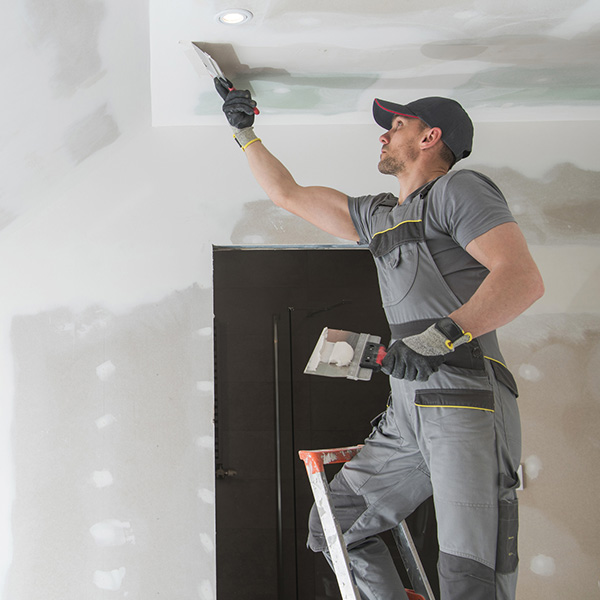Drywall Installment Facilitated: Tips for Perfect Results
Drywall setup is often viewed as an overwhelming job, yet with the appropriate strategy and expertise, it can become a manageable venture. Selecting quality products and preparing the setup area are vital very first steps that set the structure for success. Additionally, grasping methods for cutting, hanging, and finishing drywall can considerably influence the end result. As we explore these necessary ideas, you may find that even the smallest modifications in your approach can bring about remarkably enhanced results, leaving you to consider just how these methods can transform your next project.
Choosing the Right Products
Choosing the appropriate materials for drywall setup is critical to accomplishing a resilient and aesthetically pleasing coating. drywall contractor. The primary part, drywall sheets, normally come in numerous densities, with 1/2-inch sheets being typical for interior wall surfaces. For locations needing added dampness resistance, such as kitchens or washrooms, take into consideration using green board or concrete board, which are particularly made to endure moisture

Furthermore, selecting the appropriate fasteners-- either nails or screws-- is important for protecting the drywall to the framework. Drywall screws are normally favored for their holding power and minimized danger of popping. Lastly, take into consideration the complements such as guide and paint, which not only improve the appearance yet also protect the drywall from moisture and wear.
Preparing the Installation Area
Before starting the drywall setup process, it is essential to prepare the installation location extensively. A clean workspace reduces the risk of damage to existing items and enables for effective motion during installment.
Following, examine the walls and ceiling for any kind of flaws, such as splits, holes, or mold and mildew. Address these problems ahead of time; patch any type of problems and allow sufficient time for repair work to completely dry. In addition, make sure that electric outlets, switches, and pipes are appropriately placed and represented, as this will impact drywall positioning.
Think about the ecological problems. A stable temperature and humidity degree are crucial for ideal attachment and efficiency of the drywall materials. If required, utilize a dehumidifier or heating unit to develop ideal problems.
Trimming and Hanging Drywall
The trick to reliable drywall setup exists in the specific cutting and dangling of the panels. Begin by measuring the space accurately, considering any obstructions such as electric outlets or home windows. Utilize a straight side and an energy knife to rack up the drywall along your dimensions, then snap it along the scored line for a tidy break. For more intricate cuts, such as around electrical outlets, a drywall saw can be made use of for accuracy.

Always function from the top down and left to right, guaranteeing that you preserve a staggered pattern to enhance security. Properly hanging the drywall establishes the foundation click for more info for a smooth finish, ultimately leading to exceptional lead to your drywall project.
Taping and Mudding Strategies
While proper cutting and dangling of drywall sets the phase, the following important action involves understanding taping and mudding methods to guarantee a seamless finish. Taping is important for strengthening joints and avoiding fractures; it entails installing tape into the used joint substance (mud) Start with a quality fiberglass view website or paper tape, applying the tape over the joint and pressing it into the damp mud utilizing a taping knife, making sure no air bubbles stay.
When the tape remains in location, apply a thin layer of joint compound over the tape, feathering the edges to develop a smooth transition to the drywall surface. Permit this layer to dry totally before sanding it gently to remove imperfections. Repeat this process, using extra layers of mud as required-- normally 2 to 3 coats-- while slowly expanding the application area with each layer to achieve a seamless look.
After the last layer dries, sand the surface area with a fine-grit sandpaper till smooth. sheetrock repair fort worth. Remember to use a mask throughout sanding to prevent breathing in dust fragments. Grasping these taping and mudding methods is vital for achieving a professional-quality surface in your drywall installation
Completing Touches for Perfection
Attaining a perfect drywall installation goes beyond mudding and taping; it culminates in the completing touches that elevate the total look. These final steps are vital in making sure a professional-grade finish that boosts the appearances of your area.
Begin by fining sand the dried joint substance to develop a smooth surface area. drywall installation. After fining sand, wipe down the wall surfaces with a moist fabric to get rid of any kind of dirt bits, making sure a clean surface for paint.
Next, use a guide specifically made for drywall. This step is necessary, as it helps seal the joint substance and provides an uniform base for the topcoat. As soon as the primer dries, inspect for any kind of flaws, and retouch as required.
Conclusion
In verdict, effective drywall setup hinges on the careful choice of materials, comprehensive preparation of the setup area, and accurate implementation of reducing and hanging techniques. Proficiency of taping and mudding procedures is essential for achieving a smooth coating. In addition, focus to ending up touches, including priming and touch-ups, guarantees a professional-grade result. By adhering to these guidelines, the quality of craftsmanship can be substantially enhanced, contributing to the total aesthetic and performance of the area.
Drywall installment is often regarded as a complicated job, yet with the appropriate method and expertise, it can end up being a convenient undertaking.Picking the proper products for drywall installation is critical to accomplishing a durable and aesthetically pleasing surface.Before beginning the drywall installment procedure, it is necessary to prepare the setup area thoroughly. Understanding these taping and mudding strategies is vital for accomplishing a professional-quality surface in your drywall setup.
In verdict, successful drywall installation pivots on the cautious choice of products, thorough prep more info here work of the setup location, and accurate implementation of reducing and hanging techniques.